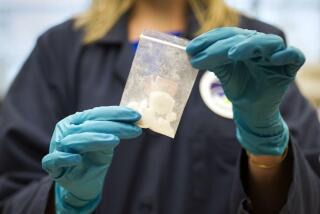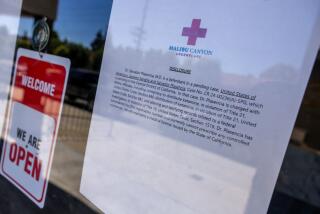Defense Expert Has an Uneven Record in Court : Evidence: Toxicologist Fredric Rieders’ testimony has been called into question in a string of high-profile cases.
When Burbank mortician Timothy Waters died in 1985 at his mother’s Camarillo home, authorities concluded that he had suffered a heart attack--until a toxicologist said he found traces of the poisonous shrub oleander in Waters’ remains.
The finding by Fredric Rieders of Philadelphia led to the filing of murder charges in 1990 against David Wayne Sconce of Glendora--charges that were dropped after another expert said that more sophisticated tests found no traces of oleander.
It was one of a string of cases in which debatable scientific testimony came from Rieders, who has now resurfaced as an expert witness for the O.J. Simpson defense, supporting a defense theory that police planted bloodstains to frame Simpson.
Prosecutor Marcia Clark earlier this week focused on Rieders’ findings in the Waters case, triggering defensive responses from Rieders, who may return to the stand later in the trial for more cross-examination.
Rieders has been involved in a series of high-profile cases in which his testimony has been vigorously called into question by prosecutors and other attorneys. He appeared in Santa Ana as a defense witness in the murder case of Richard K. Overton, a Dana Point computer consultant charged with poisoning his wife, Janet, with cyanide. Rieders testified that the cyanide could have come from the woman’s ulcer medication, but other experts unanimously disagreed, and Overton was convicted in May.
In January, Rieders testified--in a headline-making wrongful-death case against New York Hospital--that the daughter of journalist Sidney Zion had taken large doses of cocaine before dying at the facility. Most other tests found no cocaine, and a judge later threw out verdicts based on the cocaine argument.
Rieders could not be reached for comment Thursday.
As a key defense witness in the Simpson case, he testified Monday that bloodstains found on a sock in Simpson’s bedroom and on a gate near the scene of the crimes contained traces of the preservative EDTA, which police and coroner’s officials use to keep blood samples from coagulating in test tubes.
Defense attorneys say this shows that the blood identified as Nicole Brown Simpson’s, found on O.J. Simpson’s socks, came from a test tube, bolstering their contention that police deliberately stained the socks with blood to frame Simpson.
But an FBI agent testified that he got similar levels of EDTA in tests of his own blood, which had never been stored. Rieders said under cross-examination that he was surprised to hear that.
There are signs that the prosecution is working on more such surprises. Gary Gorman, a former reporter and editor for The Times who covered the Sconce case in Ventura and now lives in Ohio, confirmed this week that Los Angeles prosecutors have been in contact with him about the case, but he declined to elaborate.
Orange County prosecutors also have delivered transcripts of Rieders’ testimony in the Overton poisoning trial to their counterparts in Los Angeles.
Gigi Gordon, a defense attorney and legal analyst, said it is common practice for opposing attorneys to collect as much negative information as they can on each other’s expert witnesses.
“If a person has made a mistake in the past, obviously what he’s testifying to in the present is given less credibility,” she noted.
Judge Lance A. Ito ruled Monday that the prosecution can question Rieders about the Ventura County case, which legal experts say opens the door for Clark to portray Rieders as error-prone.
In that case, Rieders was asked to run tests on Waters--a 24-year-old Burbank mortician who died April 8, 1985--after prosecutors were tipped off by several witnesses that Sconce had boasted of poisoning Waters, a business rival.
Rieders said an analysis of Waters’ remains determined that oleander--not cardiac arrest as previously thought--was the true cause of death. The sap of the flowering bush, common in Southern California, is a strong poison.
*
Armed with Rieders’ findings, prosecutors in February, 1990, charged Sconce with murdering Waters. But the case began to unravel when a Ventura County prosecutor grew worried after studying Rieders’ test results and a 2,000-page transcript of Sconce’s preliminary hearing.
Prosecutors and Sconce’s defense attorney agreed to have additional tests performed by Jack Henion, a Cornell University professor whose methods of measuring molecular particles were considered the best.
Henion concluded that the samples taken from Waters’ remains contained no oleander, and the murder charge against Sconce was dropped.
In the Overton case, Rieders testified that the drug Ranitidine--which the victim had been taking to treat an ulcer--was capable of releasing small amounts of cyanide, said Orange County Deputy Dist. Atty. Christopher J. Evans, who prosecuted the case.
Evans called witnesses from the Food and Drug Administration, the Orange County crime lab and a private crime lab, all of whom denied that Ranitidine releases cyanide. In closing arguments, Evans said Rieders’ conclusions resulted from sloppy scientific testing. After deliberating just six hours, the jury convicted Overton.
Rieders also testified in the trial of a civil suit brought by Zion, who alleged that his teen-age daughter, Libby, had died at New York Hospital in 1984 because doctors administered the wrong drugs.
Rieders backed up the hospital’s defense that the girl had taken other drugs, including cocaine, that she did not tell doctors about. Although most laboratory reports found no traces of cocaine in her body, he testified that his analysis of the tests suggested she had snorted 100 milligrams of cocaine within 16 hours of her death.
The jury agreed, finding her 50% responsible for her death. However, in setting aside that portion of the jury’s verdict, the trial judge ruled that there was no conclusive evidence that she had taken cocaine.
More to Read
Sign up for Essential California
The most important California stories and recommendations in your inbox every morning.
You may occasionally receive promotional content from the Los Angeles Times.










